![]()
Research suggests that if you weigh yourself regularly, you will be more successful in losing weight and keeping it off in the long run. Use our free weight loss tracker printables to keep track of your weight and to keep you motivated and accountable.
Below you will find a free printable weight loss tracker template to track your weight and body measurements.
Weight loss can be slow and frustrating. Progress is often hard to see since you see yourself every day. A weight loss tracker printable shows you are making progress even when you don’t feel like you are. A body measurement tracker is important because you often lose inches, but it doesn’t show on the scale. It gives a more accurate picture of fat loss than a scale does.
There are two kinds of charts on this page: a log weight chart that logs your weight and a log weight calculator that keeps track of your weight loss or gain. Some of the versions record many more parameters such as body measurements, etc.
If you want to record your BMI, then use our BMI calculator.
You can change the backgrounds and edit the text on each of these charts. Download each template as an image file (jpg or png) or in PDF format. See body measurement chart for more charts.
![]()
![]()
This weekly tracker tracks your weight and body measurements (waist, chest, hips, left thigh, right thigh, left arm and right arm) once a week for a month.
You can change the border or background.
![]()
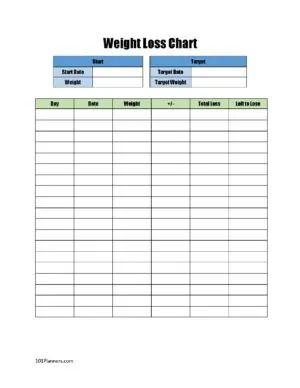
The Excel version (automatically calculates the weight loss and weight left to lose).
Here are some weight loss countdown printables that show how far you are from your goal. A weight loss graphic is a fun way to visualize how far you have come since you started.
Weight Loss Thermometer
![]()
![]()
Weight Loss Jar Printable
These charts track your weight loss as a percentage of the total weight loss you want to lose.
![]()
This is a cute weight loss tracker printable. Draw one marble for each pound or kilo you want to lose. Each time you lose one move it to the lost jar and erase it on the first jar.
The text is editable so you can change it to kilos or anything else.
These weight tracker chart printables are available in Word, PDF or Excel format and you can edit the columns and text.
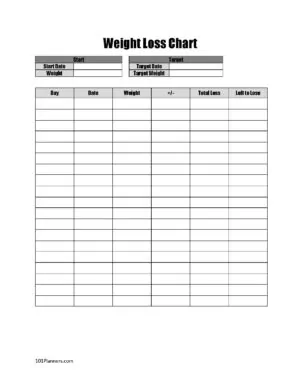
This template tracks your start weight, your goal weight, how much you lose each time, how much you have lost in total and how much you have left to lose. If you select the spreadsheet, then you only have to enter your weight and date and the rest of the calculations will be automatic.
The Excel weight loss tracker above will track your total loss and how much weight you still need to lose to reach your goal weight. Feel free to change the weight loss template if you want to make changes. You can add additional columns with measurements or delete some of the columns. Customize so that it works for you.
This is a weight loss tracking sheet in Word format above. You can change the weight loss tracker chart by adding additional columns or deleting columns you don’t want to appear. You can also edit all text.
This weight loss chart is available both in pounds and kilograms. There is space to add a weekly weigh-in but you can weigh in more or less often if you prefer. Simply enter the date of the weigh-in and the average weight loss will be calculated for you even if you weigh in weekly.
The weight loss goal chart will always keep a record of how much more you have to lose to reach your goal weight. It calculates your BMI when you start, your goal BMI and your BMI after each weigh-in. If you want to keep track of your measurements, you can add an additional column/s.
The weight loss program chart will show you how much progress you have made since you started. For each weigh-in you will see the total loss since you started and the average loss per week.
Weight loss is rarely steady and stable. It usually fluctuates and dieters often encounter plateaus for different periods of time. Therefore, a weight loss graph is a great tool to show you if you are going in the right direction at the approximate weight loss pace you initially planned. This of course, assumes that you set realistic goals for yourself.
To use this weight loss graph, complete the following details (each detail that needs to be completed is outlined in black): Initial weight, starting date, goal weight, and target weekly weight loss.
The chart will let you know when you should reach your goal weight and what weight you should be at each week assuming your weight loss will be steady (which is highly unlikely). The graph to the right will show you where you stand compared to your initial weight loss goals.
Some weeks you might be above the goal and others below the goal but a weight loss chart is still a helpful guide assuming your goals are realistic.
Body measurements for weight loss chart in different formats. You can change the border and the layout of the chart. We also offer a free printable body measurement chart in bullet journal style below.
![]()
![]()
These weight trackers will enable you to measure yourself before and after to see the improvement. Sometimes there is no change in weight but there is a change in your measurements.
A bullet journal weight tracker is a good tool to see your progress. Create a transformation tracker to track your progress before and after weight loss or over a one-year period.
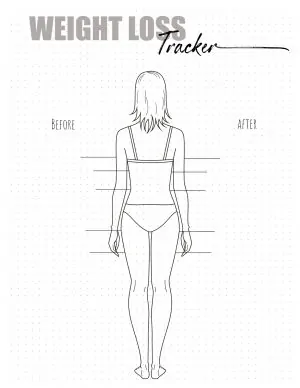
Before and After
This weight tracker bullet journal style will help you track your weight loss. Since the text is editable you can either add measurements before and after or you can record them every few months.
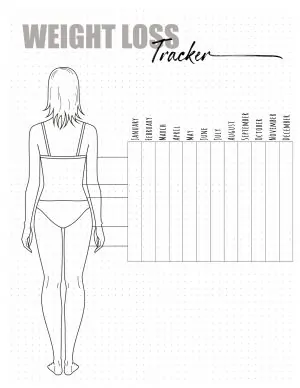
One Year Tracker
This template tracks your body’s measurements over a one-year period.
![]()
Pounds to Lose vs Pounds Lost (You can edit to Kg)
This is a fun weight loss chart. Draw one circle (marble) for each pound you have to lose. Each time you lose a pound, erase it and draw a pound in the “pounds lost” jar.
If you prefer to use kilograms instead of pounds, then edit the text.
![]()
Track the measurements of your chest, waist, upper arm, thighs, hips and your weight each month. This will show your progress both on the scale and fat loss (i.e. inches lost).
![]()
This is a 12 week weight loss tracker template. Divide the amount of weight you want to lose by 12. Mark 1/12 next to each scale. For example, if you need to lose 24 pounds then write 2 pounds less next to each scale. If you want to lose 6 pounds then each step will be half a pound. Each time you reach a milestone color the scale or mark it.
To create a weekly weight loss tracker, simply record your weight each week on the next scale.
For more weight loss printables:
I have often spent weeks watching my diet and working out regularly only to find that I haven’t lost an ounce. It is so frustrating! Sometimes the scale doesn’t budge, but we are losing fat. Taking measurements before you start trying to lose weight can help you see progress even when the scale isn’t showing any.
I hate the scale. I try not to weigh myself but I always land up getting on it eventually. I know it is just a number but that number can determine my mood that day and affects my body image. I wish I had enough willpower to only measure myself and not weigh in but I don’t. I used to ask my kids to hide the scale, but I always found it.
If you have started working out as well as eating healthy food, you might want to track your workouts as well as your weight loss. A workout journal can help you determine that your fitness is improving.
The following weight loss calendar template only tracks your weight and total weight loss. The calendar below is more flexible and you can add anything you want to it such as motivational quotes, food logs, water trackers, meal plans, habit trackers, etc.
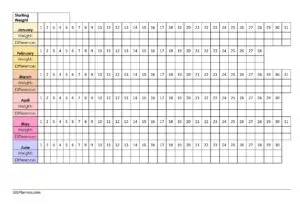
This yearly weight loss calendar is on two pages. Page one is from January to June and page two is from July to December. Each day you can record your weight and the total weight loss to date. If you use the Excel version then your total weight loss will be calculated for you.
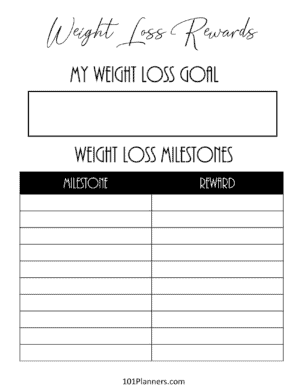
This weight-loss table includes weight loss rewards for each milestone reached. It is a great way to keep yourself motivated.
There is space for 10 milestones so divide your weight loss goal by 10 to calculate each milestone. Set a reward for reaching each milestone. See weight loss rewards for weight loss reward ideas.
Research suggests that if you weigh yourself regularly, you will be more successful in losing weight and keeping it off in the long run. If you weigh yourself at least once a week, you may have more success with weight loss than those who check in with the scale less frequently.
Weigh yourself first thing in the morning before you eat or drink anything. Use the bathroom before you weigh yourself. Either don’t wear anything or wear just underwear.
There is no consensus here. Basically, there are three different opinions:
How often should you weigh yourself? You know yourself and your body. Choose the method that works best for you but whatever you choose always weigh yourself on the same scale at the same time (preferably in the morning before you eat or drink anything).
Take measurements once every two weeks or even two months if you can wait that long. It takes a while to lose fat and you won’t see a difference right away.
Keep track of your weight and measurements in your journal. You can use our free weight loss tracker printable to record your weight and measurements.
When you see a sudden weight loss or gain, take notes in your journal to understand the pattern. For example, after recording my weight and keeping a period tracker, I realized that one week before my period I gain 2 pounds.
The lines on the body measurement tracker can be moved so you can decide what parts of your body you want to measure. These are the parts most commonly measured. You might want to make a note of where you measured in your weight loss journal so you measure the same place each time.
If the scale freaks you out and you don’t have the patience to measure yourself, you can use your clothes to check your progress. I keep a pair of jeans that I can’t get into yet to measure my progress. You might have pants that barely close. These can be helpful too to gauge progress.
Another method is to take before and after photos. You see a lot of these on Instagram and Pinterest. People pose in their underwear. You don’t have to publish these photos. You can keep them somewhere safe for your eyes only.
If you decide to weigh yourself then it is important to track your weight over time since weight fluctuates daily. Select any of the Excel documents above if you want a log weight calculator that will calculate your weight changes for you. If you don’t mind doing the calculation yourself then you can use any format (such as Word, an image, or PDF).
Do you have more printables for weight loss?
We also offer a free printable weight loss bullet journal that you can use to help motivate you and track your progress. See 89 weight loss motivation tips.
The following printables might also be helpful: